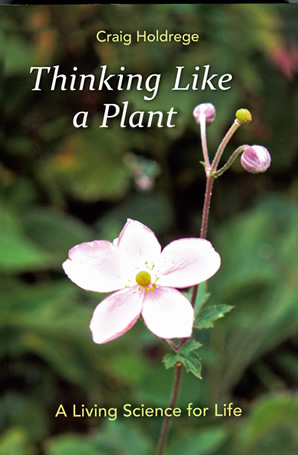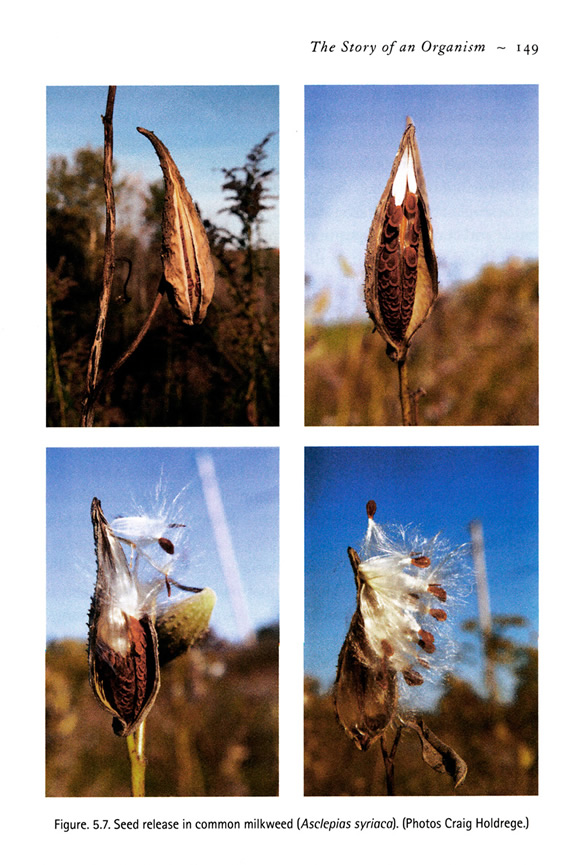Thinking Like a Plant:
|
|
Book review and appreciation by Richard Katz of a new book by
“One can hardly imagine a better teacher of dynamism, connectedness, resilience, and wholeness than a plant. ” Craig Holdrege |

|
This is much more than a book about plants, although it has much to say about how we can develop the faculties for a much deeper appreciation of the living beings we call plants. If we are receptive and awake to what a plant is, how it lives and grows, there are profound implications for the environmental movement, the philosophy of science, and for education at all levels.
What does it mean to “think like a plant" since, clearly, plants do not think as we understand that term. What Holdrege is suggesting is that we need to develop thinking that is as alive and fluid as plant life, rather than the fixed, stone-like thinking that dominates both popular and scientific culture. We can learn to think as a plant lives, constantly in flux, moving in a dynamic yet orderly way, from one stage to another, with its various parts changing shape and size, coming into being, and dropping out of being. As Holdrege describes, we also can learn from the plant’s engagement with its environment. It is not an isolated being, but one that not only derives its nourishment from its surroundings (both below and above the earth’s surface), but it also adapts itself to the surrounding conditions (temperature, moisture, light, soil texture and composition). Thinking like a plant means being receptive to new possibilities instead of being bound by fixed ideas.
|
“If we want to behold nature in a living way, we must
follow her example and become as mobile and malleable as nature herself.”
Johann Wolfgang von Goethe, as quoted and translated by Craig Holdrege. |
Holdrege also shows how we can develop this plant-like living quality of thinking in the very act of studying plants. Much of the book’s contents derive from the courses in nature study that Holdrege conducts at the Nature Institute, his adult education center in upstate New York, and his experience teaching nature science for Waldorf high schools. Anyone who has taken a course from the Flower Essence Society will recognize many themes from our hands-on plant studies, the training of the senses to register in as much detail as possible the full spectrum of characteristics of a particular plant, alternating with the inner picturing of what was outwardly perceived. As Holdrege notes, this “exact sensorial imagination,” in Goethe’s words, trains us to interiorize the sense perceptions of the plant, so that we begin to transcend the dichotomy of inner and outer experience .
The book is well organized, professionally referenced, with concepts grounded in specific examples of plant studies, perception exercises, and comments from Nature Institute students. The book begins with a description of the conventional, Object-oriented thinking, the analytic approach to science and thinking that has resulted in tremendous progress in human technology and freedom, but which is inadequate for a fuller participation in life.
Object-oriented thinking is then contrasted with thinking grounded in a living relationship with nature, an active engagement as already described. Holdrege then devotes chapters to the two major lessons that plants can teach us, transformation and relationship (context). We then are treated to a most delightful and insightful plant study of the common Milkweed (Asclepius syratica) . The details draw us into a very intimate relationship with the plant, and that is as much the point of the study, not just learning a new set of “facts.”
|
"One interesting feature of pod development is that the stalk that carries the pod—regardless of the angle at which it originally extends from the umbel's stalk—twists and curves into a position such that the pod becomes oriented vertically. ... The suture along the convex side of the pod splits open and the neatly ordered, tightly packed seeds become visible (Figure 5.7). It looks as if an artist had laid the seeds out. With further opening of the pod, the seeds begin to fall and float away..."
|
 Holdrege reminds us of a very significant truth, that we
cannot solve problems with the same frame of mind that created them. In order
to truly turn around the ecological crisis of our time, it is not adequate to
engineer fixes to the environment.
We must transform our
relationship
with
nature so that we are no longer onlookers to a world that is escaping our
control. Rather, we are participants in nature.
We are in nature and she is in
us, and we must act out of the same loving care that we feel for our own
family. (This is the message, by the way, of the
FES Grounding Green formula
,
and especially the Green Rein Orchid flower essence.)
Holdrege reminds us of a very significant truth, that we
cannot solve problems with the same frame of mind that created them. In order
to truly turn around the ecological crisis of our time, it is not adequate to
engineer fixes to the environment.
We must transform our
relationship
with
nature so that we are no longer onlookers to a world that is escaping our
control. Rather, we are participants in nature.
We are in nature and she is in
us, and we must act out of the same loving care that we feel for our own
family. (This is the message, by the way, of the
FES Grounding Green formula
,
and especially the Green Rein Orchid flower essence.)
The book concludes with the implications for education, a plea for a “quiet revolution” in how we learn, one based on the living thinking that the plant teaches us. Much appreciation is due to Craig Holdrege and his colleagues for not only articulating this enlivened vision of education, but also pioneering the experience of such education through the Nature Institute, and various guest lectures and workshops.
Students of flower essence therapy, and all those who work with soul therapies will find much of value for their work in this book, and in the larger opus of the Nature Institute . Thinking like a plant grows is also thinking like a soul grows. Object-oriented thinking treats physical and emotional suffering as a condition to be fixed. The symptom-remedy approach, whether in conventional or “natural” medicine, lacks an appreciation for the dynamic transformative process of the soul. As flower essence therapists, we need to consider the stages of development of our client, the social and other relationships that form the context for the suffering, and the opportunities that these challenges present. Like the plant, the soul can meet outer conditions and challenges by cultivating flexibility and receptivity, while remaining true to its essential nature.
Richard Katz founded the Flower Essence Society in 1979. His many decades of research into flower essences has been immensely enriched by his contact with the Goethean Science approach to nature study, epitomized by Holdrege’s book.
Craig Holdrege, PhD , is the director of the Nature Institute in Ghent, NY, a center for nature research and adult education. His publications include the books Genetics and the Manipulation of Life: The Forgotten Factor of Context, and The Giraffe’s Long Neck: From Evolutionary Fable to Whole Organism, and numerous articles, many of which can be found in the journal of the Natural Institute, “ In Context ” and throughout the Nature Institute website .
Thinking Like a Plant is published by Lindisfarne Press, Great Barrington, MA, 02013, and is available through SteinerBooks , as well as through many book stores and online shops.

To install this Web App in your iPhone/iPad press ![]() and then Add to Home Screen.
and then Add to Home Screen.
